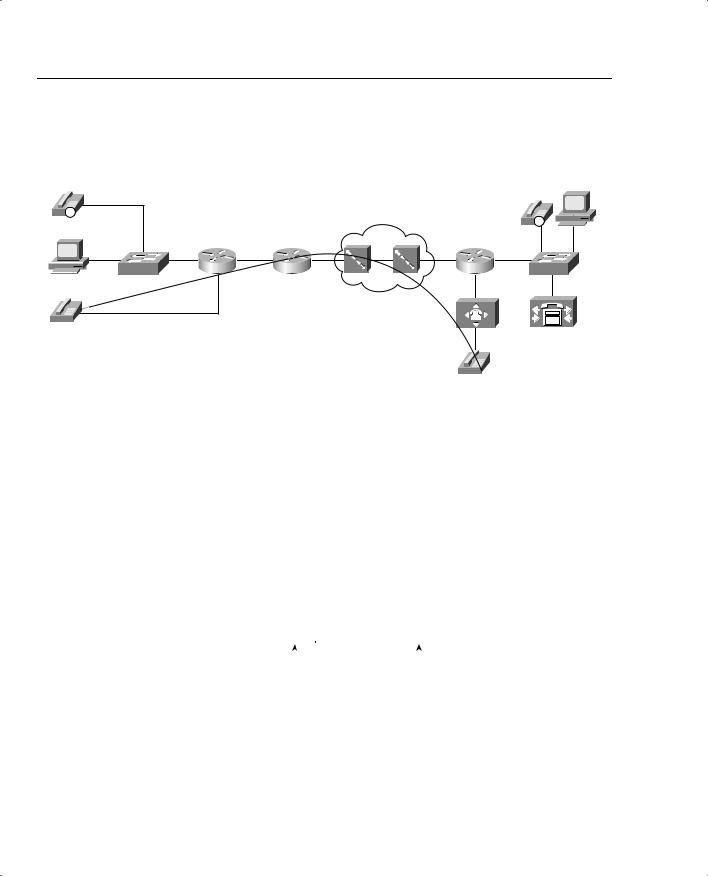
- •QoS Overview
- •“Do I Know This Already?” Quiz
- •QoS: Tuning Bandwidth, Delay, Jitter, and Loss Questions
- •Foundation Topics
- •QoS: Tuning Bandwidth, Delay, Jitter, and Loss
- •Bandwidth
- •The clock rate Command Versus the bandwidth Command
- •QoS Tools That Affect Bandwidth
- •Delay
- •Serialization Delay
- •Propagation Delay
- •Queuing Delay
- •Forwarding Delay
- •Shaping Delay
- •Network Delay
- •Delay Summary
- •QoS Tools That Affect Delay
- •Jitter
- •QoS Tools That Affect Jitter
- •Loss
- •QoS Tools That Affect Loss
- •Summary: QoS Characteristics: Bandwidth, Delay, Jitter, and Loss
- •Voice Basics
- •Voice Bandwidth Considerations
- •Voice Delay Considerations
- •Voice Jitter Considerations
- •Voice Loss Considerations
- •Video Basics
- •Video Bandwidth Considerations
- •Video Delay Considerations
- •Video Jitter Considerations
- •Video Loss Considerations
- •Comparing Voice and Video: Summary
- •IP Data Basics
- •Data Bandwidth Considerations
- •Data Delay Considerations
- •Data Jitter Considerations
- •Data Loss Considerations
- •Comparing Voice, Video, and Data: Summary
- •Foundation Summary
- •QoS Tools and Architectures
- •“Do I Know This Already?” Quiz
- •QoS Tools Questions
- •Differentiated Services Questions
- •Integrated Services Questions
- •Foundation Topics
- •Introduction to IOS QoS Tools
- •Queuing
- •Queuing Tools
- •Shaping and Policing
- •Shaping and Policing Tools
- •Congestion Avoidance
- •Congestion-Avoidance Tools
- •Call Admission Control and RSVP
- •CAC Tools
- •Management Tools
- •Summary
- •The Good-Old Common Sense QoS Model
- •GOCS Flow-Based QoS
- •GOCS Class-Based QoS
- •The Differentiated Services QoS Model
- •DiffServ Per-Hop Behaviors
- •The Class Selector PHB and DSCP Values
- •The Assured Forwarding PHB and DSCP Values
- •The Expedited Forwarding PHB and DSCP Values
- •The Integrated Services QoS Model
- •Foundation Summary
- •“Do I Know This Already?” Quiz Questions
- •CAR, PBR, and CB Marking Questions
- •Foundation Topics
- •Marking
- •IP Header QoS Fields: Precedence and DSCP
- •LAN Class of Service (CoS)
- •Other Marking Fields
- •Summary of Marking Fields
- •Class-Based Marking (CB Marking)
- •Network-Based Application Recognition (NBAR)
- •CB Marking show Commands
- •CB Marking Summary
- •Committed Access Rate (CAR)
- •CAR Marking Summary
- •Policy-Based Routing (PBR)
- •PBR Marking Summary
- •VoIP Dial Peer
- •VoIP Dial-Peer Summary
- •Foundation Summary
- •Congestion Management
- •“Do I Know This Already?” Quiz
- •Queuing Concepts Questions
- •WFQ and IP RTP Priority Questions
- •CBWFQ and LLQ Questions
- •Comparing Queuing Options Questions
- •Foundation Topics
- •Queuing Concepts
- •Output Queues, TX Rings, and TX Queues
- •Queuing on Interfaces Versus Subinterfaces and Virtual Circuits (VCs)
- •Summary of Queuing Concepts
- •Queuing Tools
- •FIFO Queuing
- •Priority Queuing
- •Custom Queuing
- •Weighted Fair Queuing (WFQ)
- •WFQ Scheduler: The Net Effect
- •WFQ Scheduling: The Process
- •WFQ Drop Policy, Number of Queues, and Queue Lengths
- •WFQ Summary
- •Class-Based WFQ (CBWFQ)
- •CBWFQ Summary
- •Low Latency Queuing (LLQ)
- •LLQ with More Than One Priority Queue
- •IP RTP Priority
- •Summary of Queuing Tool Features
- •Foundation Summary
- •Conceptual Questions
- •Priority Queuing and Custom Queuing
- •CBWFQ, LLQ, IP RTP Priority
- •Comparing Queuing Tool Options
- •“Do I Know This Already?” Quiz
- •Shaping and Policing Concepts Questions
- •Policing with CAR and CB Policer Questions
- •Shaping with FRTS, GTS, DTS, and CB Shaping
- •Foundation Topics
- •When and Where to Use Shaping and Policing
- •How Shaping Works
- •Where to Shape: Interfaces, Subinterfaces, and VCs
- •How Policing Works
- •CAR Internals
- •CB Policing Internals
- •Policing, but Not Discarding
- •Foundation Summary
- •Shaping and Policing Concepts
- •“Do I Know This Already?” Quiz
- •Congestion-Avoidance Concepts and RED Questions
- •WRED Questions
- •FRED Questions
- •Foundation Topics
- •TCP and UDP Reactions to Packet Loss
- •Tail Drop, Global Synchronization, and TCP Starvation
- •Random Early Detection (RED)
- •Weighted RED (WRED)
- •How WRED Weights Packets
- •WRED and Queuing
- •WRED Summary
- •Flow-Based WRED (FRED)
- •Foundation Summary
- •Congestion-Avoidance Concepts and Random Early Detection (RED)
- •Weighted RED (WRED)
- •Flow-Based WRED (FRED)
- •“Do I Know This Already?” Quiz
- •Compression Questions
- •Link Fragmentation and Interleave Questions
- •Foundation Topics
- •Payload and Header Compression
- •Payload Compression
- •Header Compression
- •Link Fragmentation and Interleaving
- •Multilink PPP LFI
- •Maximum Serialization Delay and Optimum Fragment Sizes
- •Frame Relay LFI Using FRF.12
- •Choosing Fragment Sizes for Frame Relay
- •Fragmentation with More Than One VC on a Single Access Link
- •FRF.11-C and FRF.12 Comparison
- •Foundation Summary
- •Compression Tools
- •LFI Tools
- •“Do I Know This Already?” Quiz
- •Foundation Topics
- •Call Admission Control Overview
- •Call Rerouting Alternatives
- •Bandwidth Engineering
- •CAC Mechanisms
- •CAC Mechanism Evaluation Criteria
- •Local Voice CAC
- •Physical DS0 Limitation
- •Max-Connections
- •Voice over Frame Relay—Voice Bandwidth
- •Trunk Conditioning
- •Local Voice Busyout
- •Measurement-Based Voice CAC
- •Service Assurance Agents
- •SAA Probes Versus Pings
- •SAA Service
- •Calculated Planning Impairment Factor
- •Advanced Voice Busyout
- •PSTN Fallback
- •SAA Probes Used for PSTN Fallback
- •IP Destination Caching
- •SAA Probe Format
- •PSTN Fallback Scalability
- •PSTN Fallback Summary
- •Resource-Based CAC
- •Resource Availability Indication
- •Gateway Calculation of Resources
- •RAI in Service Provider Networks
- •RAI in Enterprise Networks
- •RAI Operation
- •RAI Platform Support
- •Cisco CallManager Resource-Based CAC
- •Location-Based CAC Operation
- •Locations and Regions
- •Calculation of Resources
- •Automatic Alternate Routing
- •Location-Based CAC Summary
- •Gatekeeper Zone Bandwidth
- •Gatekeeper Zone Bandwidth Operation
- •Single-Zone Topology
- •Multizone Topology
- •Zone-per-Gateway Design
- •Gatekeeper in CallManager Networks
- •Zone Bandwidth Calculation
- •Gatekeeper Zone Bandwidth Summary
- •Integrated Services / Resource Reservation Protocol
- •RSVP Levels of Service
- •RSVP Operation
- •RSVP/H.323 Synchronization
- •Bandwidth per Codec
- •Subnet Bandwidth Management
- •Monitoring and Troubleshooting RSVP
- •RSVP CAC Summary
- •Foundation Summary
- •Call Admission Control Concepts
- •Local-Based CAC
- •Measurement-Based CAC
- •Resources-Based CAC
- •“Do I Know This Already?” Quiz
- •QoS Management Tools Questions
- •QoS Design Questions
- •Foundation Topics
- •QoS Management Tools
- •QoS Device Manager
- •QoS Policy Manager
- •Service Assurance Agent
- •Internetwork Performance Monitor
- •Service Management Solution
- •QoS Management Tool Summary
- •QoS Design for the Cisco QoS Exams
- •Four-Step QoS Design Process
- •Step 1: Determine Customer Priorities/QoS Policy
- •Step 2: Characterize the Network
- •Step 3: Implement the Policy
- •Step 4: Monitor the Network
- •QoS Design Guidelines for Voice and Video
- •Voice and Video: Bandwidth, Delay, Jitter, and Loss Requirements
- •Voice and Video QoS Design Recommendations
- •Foundation Summary
- •QoS Management
- •QoS Design
- •“Do I Know This Already?” Quiz
- •Foundation Topics
- •The Need for QoS on the LAN
- •Layer 2 Queues
- •Drop Thresholds
- •Trust Boundries
- •Cisco Catalyst Switch QoS Features
- •Catalyst 6500 QoS Features
- •Supervisor and Switching Engine
- •Policy Feature Card
- •Ethernet Interfaces
- •QoS Flow on the Catalyst 6500
- •Ingress Queue Scheduling
- •Layer 2 Switching Engine QoS Frame Flow
- •Layer 3 Switching Engine QoS Packet Flow
- •Egress Queue Scheduling
- •Catalyst 6500 QoS Summary
- •Cisco Catalyst 4500/4000 QoS Features
- •Supervisor Engine I and II
- •Supervisor Engine III and IV
- •Cisco Catalyst 3550 QoS Features
- •Cisco Catalyst 3524 QoS Features
- •CoS-to-Egress Queue Mapping for the Catalyst OS Switch
- •Layer-2-to-Layer 3 Mapping
- •Connecting a Catalyst OS Switch to WAN Segments
- •Displaying QoS Settings for the Catalyst OS Switch
- •Enabling QoS for the Catalyst IOS Switch
- •Enabling Priority Queuing for the Catalyst IOS Switch
- •CoS-to-Egress Queue Mapping for the Catalyst IOS Switch
- •Layer 2-to-Layer 3 Mapping
- •Connecting a Catalyst IOS Switch to Distribution Switches or WAN Segments
- •Displaying QoS Settings for the Catalyst IOS Switch
- •Foundation Summary
- •LAN QoS Concepts
- •Catalyst 6500 Series of Switches
- •Catalyst 4500/4000 Series of Switches
- •Catalyst 3550/3524 Series of Switches
- •QoS: Tuning Bandwidth, Delay, Jitter, and Loss
- •QoS Tools
- •Differentiated Services
- •Integrated Services
- •CAR, PBR, and CB Marking
- •Queuing Concepts
- •WFQ and IP RTP Priority
- •CBWFQ and LLQ
- •Comparing Queuing Options
- •Conceptual Questions
- •Priority Queuing and Custom Queuing
- •CBWFQ, LLQ, IP RTP Priority
- •Comparing Queuing Tool Options
- •Shaping and Policing Concepts
- •Policing with CAR and CB Policer
- •Shaping with FRTS, GTS, DTS, and CB Shaping
- •Shaping and Policing Concepts
- •Congestion-Avoidance Concepts and RED
- •WRED
- •FRED
- •Congestion-Avoidance Concepts and Random Early Detection (RED)
- •Weighted RED (WRED)
- •Flow-Based WRED (FRED)
- •Compression
- •Link Fragmentation and Interleave
- •Compression Tools
- •LFI Tools
- •Call Admission Control Concepts
- •Local-Based CAC
- •Measurement-Based CAC
- •Resources-Based CAC
- •QoS Management Tools
- •QoS Design
- •QoS Management
- •QoS Design
- •LAN QoS Concepts
- •Catalyst 6500 Series of Switches
- •Catalyst 4500/4000 Series of Switches
- •Catalyst 3550/3524 Series of Switches
- •Foundation Topics
- •QPPB Route Marking: Step 1
- •QPPB Per-Packet Marking: Step 2
- •QPPB: The Hidden Details
- •QPPB Summary
- •Flow-Based dWFQ
- •ToS-Based dWFQ
- •Distributed QoS Group–Based WFQ
- •Summary: dWFQ Options

32 Chapter 1: QoS Overview
Summary: QoS Characteristics: Bandwidth, Delay, Jitter, and Loss
This book covers a wide variety of QoS tools, and every tool either directly or indirectly affects bandwidth, delay, jitter, or loss. Some tools improve a QoS characteristic for one packet, but degrade it for others. For example, queuing tools might let one packet go earlier, reducing delay, while increasing delay for other packets. Some QoS tools directly impact one characteristic, but indirectly affect others. For instance, RED manages loss directly, but it indirectly reduces delay for some flows because RED generally causes queue sizes to decrease.
As this book explains each new feature in detail, you will also find a summary of how the feature manages bandwidth, delay, jitter, and loss.
Traffic Characteristics of Voice, Video, and Data
So why do you need QoS? QoS can affect a network’s bandwidth, delay, jitter, and packet loss properties. Applications have different requirements for bandwidth, delay, jitter, and packet loss. With QoS, a network can better provide the right amounts of QoS resources for each application. Table 1-10 lists some major application categories, along with their typical needs for network resources and behavior.
Table 1-10 Applications and Their QoS Needs
|
Bandwidth |
Delay |
Jitter |
Loss |
|
|
|
|
|
Interactive |
Low |
Low |
Medium/high |
Low |
|
|
|
|
|
Batch |
High |
High |
High |
Low |
|
|
|
|
|
Voice |
Low |
Low |
Low |
Low |
|
|
|
|
|
Interactive Video |
High |
Low |
Low |
Low |
|
|
|
|
|
1-Way Video |
High |
Medium/high |
Low |
Low |
|
|
|
|
|
“Fragile” (For |
Low |
Low |
Medium/high |
None |
Instance, SNA*) |
|
|
|
|
|
|
|
|
|
*SNA = Systems Network Architecture
The table states the QoS requirements of different applications. For instance, interactive data applications typically don’t need much bandwidth, although one might argue that a lot of web applications do require a lot of bandwidth. Similarly, voice requires relatively little bandwidth, but requires low delay and low jitter; otherwise, the voice quality suffers significantly. Interactive video, such as video conferencing, has the same characteristics as voice, except it requires much more bandwidth. One-way video, however, can tolerate with long delays, so long as jitter does not exceed the jitter buffer on the receiving side. If you are watching a video over the Internet, for example, and if it takes 20 seconds to start, but it looks and sounds good for the next half hour, you really don’t care that the average packet is taking 10 seconds to traverse the network.

Traffic Characteristics of Voice, Video, and Data 33
The QoS course specifically mentions a category called fragile, implying that some applications are totally intolerant of packet loss. I personally would not put SNA in this category—I included it in the book, however, because it is in a table from the QoS course, which of course is the basis for the CCIP QoS Exam questions
The next three sections cover voice, video, and data flows.
Voice Traffic Characteristics
Voice traffic can degrade quickly in networks without QoS tools. This section explains enough about voice traffic flows to enable the typical reader to understand how each of the QoS tools applies to voice.
NOTE This book does not cover voice in depth because the details are not directly related to QoS. For additional information, refer to the following sources:
Deploying Cisco Voice over IP Solutions, Cisco Press, Davidson and Fox
IP Telephony, Hewlett-Packard Professional Books, Douskalis
Voice over IP Fundamentals, Cisco Press, Davidson and Peters
IP Telephone, McGraw Hill, Goralski and Kolon
www.cisco.com/warp/public/788/voip/delay-details.html)
Without QoS, the listener experiences a bad call. The voice becomes choppy or unintelligible. Delays can cause poor interactivity—for instance, the two callers keep starting to talk at the same time, because the delays sound like the other person speaking has finished what he or she had to say. Speech is lost, so that there is a gap in the sound that is heard. Calls might even be disconnected.
Most QoS issues can be broken into an analysis of the four QoS characteristics: bandwidth, delay, jitter, and loss. The basics of voice over data networks is covered first, followed by QoS details unique to voice in terms of the four QoS characteristics.
Voice Basics
Voice over data includes Voice over IP (VoIP), Voice over Frame Relay (VoFR), and Voice over ATM (VoATM). Each of these three voice over data technologies transports voice, and each is slightly different. Most of the questions you should see on an exam will be related to VoIP, and not VoFR or VoATM, because of the three options, VoIP is the most pervasive. Also calls between Cisco IP Phones use VoIP, not VoFR or VoATM.

34 Chapter 1: QoS Overview
Imagine a call between the two analog phones in Figure 1-17, extensions 201 and 301.
Figure 1-17 Call Between Analog Phones at Extensions 301 and 201
Server 1
IP |
|
|
|
|
|
|
|
|
|
|
|
|
|
|
|
|
IP |
Hannah |
|
|
|
|
|
|
|
|
|
|
|
|
|
|
|
|
FA0/0 |
SW1 |
R1 |
s0 |
s0 |
R2 |
s1 |
T1 s0/0 |
R3 |
SW2 |
201
301
Before the voice can be heard at the other end of the call, several things must happen. Either user must pick up the phone and dial the digits. The router connected to the phone interprets the digits and uses signaling to set up the VoIP call. (Because both phones are plugged into FXS analog ports on R1 and R3, the routers use H.323 signaling.) At various points in the signaling process, the caller hears ringing, and the called party hears the phone ringing. The called party picks up the phone, and call setup is complete.
The actual voice call (as opposed to signaling) uses Real-Time Transport Protocol (RTP). Figure 1-18 outlines the format of an IP packet using RTP.
Figure 1-18 IP Packet for Voice Call: RTP
20 Bytes |
|
8 Bytes |
12 Bytes |
Variable |
|||
IP |
|
UDP |
|
RTP |
Voice Payload |
||
|
|
|
|
|
|
|
|
|
|
|
|
|
|||
|
|
|
|
|
|
||
|
Port Ranges: |
|
Popular Values: |
||||
|
16384 - 32767 |
|
G.711: 160 Bytes |
||||
|
(Even Ports) |
|
G729a: 20 Bytes |
||||
In the call between the two analog phones, the router collects the analog voice, digitizes the voice, encodes the voice using a voice codec, and places the encoded voice into the payload field shown in Figure 1-18. For instance, R1 would create an IP packet as shown in Figure 1-18, place the encoded voice bits into the voice payload field, and send the packet. The source IP

Traffic Characteristics of Voice, Video, and Data 35
address would be an IP address on R1, and the destination IP address would be an IP address on R3. When R3 receives the packet, it reverses the process, eventually playing the analog waveform for the voice out to the analog phone.
The IP Phones would experience a similar process in concept, although the details differ. The signaling process includes the use of Skinny Station Control Protocol (SSCP), with flows between each phone and the Cisco CallManager server. After signaling has completed, an RTP flow has been completed between the two phones. CallManager does not participate directly in
the actual call, but only in call setup and teardown. (CallManager does maintain a TCP connection to each phone for control function support.) R1 and R3 do not play a role in the creation of the RTP packets on behalf of the IP Phone, because the IP Phones themselves create the packets. As far as R1 and R3 are concerned, the packets sent by the IP Phones are just IP packets.
Finally, the network administrator can choose from various coders/decoders (codecs) for the VoIP calls. Codecs process the incoming analog signal and convert the signal into a digital (binary) signal. The actual binary values used to represent the voice vary based on which codec is used. Each codec has various features, the most significant feature being the amount of bandwidth required to send the voice payload created by the codec. Table 1-11 lists the most popular codecs, and the bandwidth required for each.
Table 1-11 Popular Voice Codecs and Payload Bandwidth Requirements
|
Bit Rate for |
Size of payload (20-ms |
Codec |
Payload* (in kbps) |
Default in Cisco IOS Software) |
|
|
|
G.711 Pulse Code |
64 |
160 bytes |
Modulation (PCM) |
|
|
|
|
|
G.726 ADPCM |
32 |
80 bytes |
|
|
|
G.729 |
8 |
20 bytes |
|
|
|
G.723.1 ACELP |
5.3 |
20 bytes** |
|
|
|
*The payload contains the digitized voice, but does not include headers and trailers used to forward the voice traffic.
**G.723 defaults to a 30-ms payload per packet.
This short section on voice basics (and yes, it is very basic!) can be summarized as follows:
•Various voice signaling protocols establish an RTP stream between the two phones, in response to the caller pressing digits on the phone.
•RTP streams transmit voice between the two phones (or between their VoIP gateways).
Why the relatively simple description of voice? All voice payload flows need the same QoS characteristics, and all voice signaling flows collectively need another set of QoS characteristics. While covering each QoS tool, this book suggests how to apply the tool to “voice”—for two subcategories, namely voice payload (RTP packets) and voice signaling. Table 1-12 contrasts the QoS requirements of voice payload and signaling flows.
